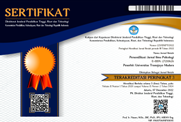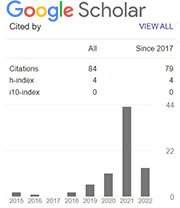Wisata Super Premium Labuan Bajo: Mengkaji Peran Langsung dan Tidak Langsung Terhadap Visiting Intention Ditinjau dari Destination Image dan Tourist Expectation
Abstract
The Indonesian government was planning a super premium tour of Labuan Bajo to be realized in 2020. Still, the change in this type of tourism resulted in various changes in travel behaviour. This study aims to examine the direct and indirect role of visiting intentions to Labuan Bajo through the destination image and tourist expectation. This research involved 141 tourists who have been and who have a desire to visit Labuan Bajo. Researchers used three scales of analysis, namely the scale of destination image, traveller expectations and visiting intentions. The analysis of this study uses multiple linear regression. The results showed a direct or indirect role of the destination image toward visiting intentions. There are two direct roles obtained, the first direct role from the destination image to the visiting intention and the other direct role from tourist's expectation towards visiting intentions. In contrast, the indirect role of the destination image generated through the expectation of a traveller toward visiting intention. Other results show that there is a simultaneous role between destination image and tourist expectations of the intention to visit Labuan Bajo.
Keywords
Full Text:
PDF (Bahasa Indonesia)References
Abubakar, M., & Ilkan, M. (2016). Impact of online WOM on destination trust and intention to travel: A medical tourism perspective. Journal of Destination Marketing and Management 5(3). DOI: 10.1016/j.jdmm.2015.12.005
Ab, A. (2018). Pengaruh Citra Destinasi Terhadap Intensi Wisatawan Berkunjung Kembali di Sulawesi Selatan Tahun. Jurnal Ilmu-Ilmu Sosial Dan Humaniora, 20(3), 207–214. https://doi.org/10.24198/sosiohumaniora.v20i3.14050
Ajzen, I. (1991). The Theory of Planned Behavior. Organizational Behavior and Human Decision Processes, 50.
Ajzen, I. (2005). Attitudes, Personality and Behaviour. (T. Manstead, Ed.) (Second Edi). New York: Open University Press.
Azwar, S. (2012). Reliabilitas dan Validitas.Yogyakarta: Pustaka Pelajar
Badan Pusat Statistik Provinsi Bali. (2020). Jumlah Wisatawan Asing ke Bali Menurut Bulan, 1982-2019. https://bali.bps.go.id/statictable/2018/02/09/21/jumlah-wisatawan-asing-ke-bali-menurut-bulan-1982-2019.html
Bhat, M.A., & Qadir, N. (2013). Tourist satisfaction in Kashmir: An empirical assessment. DOI: 10.22158/jbtp.v1n1p152
Bhat, A.M., & Qadir,N.(2013). An Emperical Assessment of Tourists’ Expectations and Perceptions. International Journal of Applied Services Marketing Perspectives. Volume 2, Number 2.
Bosque, I.R & Martín, H.S. (2008). Tourist satisfaction a cognitive-affective model. Annals of Tourism Research. Volume 35, Issue 2. https://doi.org/10.1016/j.annals.2008.02.006
Bosque, I.R., Martin, H.S., Collado, J., & Salmones, M.M.G ( 2009). A Framework for Tourist Expectations. International Journal of Culture, Tourism, and Hospitality Research. Vol. 3 NO. 2. Emerald Group Publishing Limited
Chen, C., & Tsai, D. (2007). How destination image and evaluative factors affect behavioral intentions ? Tourism Management, 28, 1115–1122. https://doi.org/10.1016/j.tourman.2006.07.007
CNN. (2019). NTT, Destinasi Wisata Terbaik dan Murah Pilihan Lonely Planet. https://www.cnnindonesia.com/gaya-hidup/20191024165021-269-442586/ntt-destinasi-wisata-terbaik-dan-murah-pilihan-lonely-planet
Coban, S. (2012). The The Effects of the Image of Destination on Tourist Satisfaction and Loyalty : The Case of Cappadocia. European Journal of Social Sciences, 29 No.2(March 2012). https://www.researchgate.net/publication/267265793%0AThe
Destari, F. (2017). Meningkatkan Intention To Revisit Melalui Keunikan Jasa Pariwisata & Destination Image : Studi Kasus Pada Big FJC. Jurnal Manajemen Dan Kearifan Lokal Indonesia, 1(1), 44–58.
DetikTravel. (2019). 6 Objek Wisata Favorit di Labuan Bajo. https://travel.detik.com/domestic-destination/d-4442351/6-objek-wisata-favorit-di-labuan-bajo
Dominique-Ferreira, S.. (2011). Destination image: Origins, Developments and Implications. Revista de Turismo y Patrimonio Cultural. 9. 305-315. https://doi.org/10.25145/j.pasos.2011.09.027
Devi. Ma., (2014). Empirical Study of Identifying the antecedent and consequences of destination image. International Journal of Innovative Research and studies. Vol.3, Issue.6.
Ghozali, I. (2013). Aplikasi Analisis Multivariate dengan Program IBM SPSS 21 Update PLS Regresi. Semarang: Badan Penerbit Universitas Diponegoro.
Gnoth, J. (1997). Tourism motivation and expectation formation. Annals of Tourism Research, Vol. 24, No. 2.
Gursoy. D., Chen. JS., Chi. G-Chi. (2014). Theoretical examination of destination loyalty formation. International Journal of Contemporary Hospitality Management. Vol. 26 Iss. 5 http://dx.doi.org/10.1108/IJCHM-12-2013-0539
Habibie, F. H., Gantina, D., & Lintang, Y. (2019). The Importance of Destination Image for Tourists Visiting Kepulauan Seribu. CATEA, 1988, 321–329.
Hanif, A., Kusumawati & Mawardi. (2016). Pengaruh Citra Destinasi Terhadap Kepuasan Wisatwan Serta Dampaknya Terhadap Loyalitas Wisatawan (Studi pada Wisatawan Nusantara yang Berkunjung ke Kota Batu). Jurnal Administrasi Bisnis (JAB), 38(1), 44–52.
Huang, S. S., & Veen, R. Van Der. (2018). The moderation of gender and generation in the effects of perceived destination image on tourist attitude and visit intention : A study of potential Chinese visitors to Australia. Journal of Vacation Marketing, 1–15. https://doi.org/10.1177/1356766718814077
Jalilvand, M. R. (2012). The Effect of Electronic Word of Mouth on Brand Image and Purchase Intention : An Empirical Study in The Automobile Industry in Iran. Marketing Intelligence & Planning. https://doi.org/10.1108/02634501211231946
Jehane, P. T., Soeprihanto, J., & Damanik, J. (2019). Penerapan Teori Planned Behavior Dalam Memprediksi Intensi Berkunjung di Objek Wisata Pasar Malam, Kota Kupang. Jurnal Tourism, 02(01), 39–46.
Jusoh, J., Masron, T., Hamid, N.F.A., & Shahrin, N. (2013). Tourist Expectation and Satisfaction towards Physical Infrastructure and Heritage Elements in Melaka UNESCO World Heritage Site. Academic Journal of Interdisciplinary Studies. Vol 2. No.8. Doi:10.5901/ajis.2013.v2n8p733
Karunia. (2019). Aksesibilitas Hambat Labuan Bajo Jadi Destinasi Super Premium?. https://money.kompas.com/read/2019/12/11/122102726/aksesibilitas-hambat-labuan-bajo-jadi-destinasi-super-premium
Kim, H & Richardson, S. (2003). Motion Picture Impacts on Destination Images. Annals of Tourism Research. 30. 216-237. https://doi.org/10.1016/S0160-7383(02)00062-2
Kim, S., & Jun, J. (2016). Journal of Hospitality and Tourism Management The impact of event advertising on attitudes and visit intentions. Journal of Hospitality and Tourism Management, 29, S37–S62. https://doi.org/10.1016/j.jhtm.2016.04.002
Louise, A., & Jørgensen, G. (2004). An analysis of a destination ’ s image and the language of tourism. The Aarhus School of Business.
Machrus, H., & Purwono, U. (2010). Behavioral Measurement based on Theory of Planned Behaviour. INSAN, 12-No. 1.
Margareth. (2019). 5 Wisata Populer NTT Kampung Halaman Johnny G Plate. https://www.tagar.id/5-wisata-populer-ntt-kampung-halaman-johnny-g-plate
Mohammed, A., & Ilkan, M. (2016). Journal of Destination Marketing & Management Impact of online WOM on destination trust and intention to travel : A medical tourism perspective. Journal of Destination Marketing & Management, 1–10. https://doi.org/10.1016/j.jdmm.2015.12.005
Myagmarsuren. O., Chen. C.F., (2011). Exploring Relationships between Destination Brand Equity, Satisfaction,and Destination Loyalty: A Case Study of Mongolia. Journal of Tourism, Hospitality & Culinary Arts. Vol. 3, Issue. 2.
Nafis, R. W., Sudarmiatin, & Sutrisno. (2019). The Effect of Tourism Attractiveness and Destination Image on Revisit Intention Through Tourist Satisfaction (Study on Domestic Tourists of Mount Bromo , Malang , East Java). European Journal of Business and Management, 11(11), 92–97. https://doi.org/10.7176/EJBM
Nurhayati, N., & Sahrah, A. (2017). Pengaruh Citra Tujuan Wisata dan Kepuasan Wisatawan Terhadap Intensi Berkunjung Kembali Wisatwan Mancanegara di Daerah Istimewa Yogyakarta. Jurnal Ilmiah Psikologi Psikologi, 11.
Oliver, R.L. (1997) Satisfaction: A Behavioral Perspective on the Consumer. The McGraw-Hill Companies, Inc., New York.
Prayag, G. (2008). Image, Satisfaction and Loyalty—The Case of Cape Town. Anatolia. 19. 205-224. https://doi.org/10.1080/13032917.2008.9687069
Provisinsi Nusa Tenggara Timur. (2019). Jumlah Wisatawan Mancanegara dan Domestik di Provinsi Nusa Tenggara Timur, 2014‒2018. http://nttprov.go.id/2018/index.php/potensi-daerah/pariwisata
Rajesh, R.. (2013). Impact of Tourist Perceptions, Destination Image and Tourist Satisfaction on Destination Loyalty: A Conceptual Model. Revista de Turismo y Patrimonio Cultural. 11. 67-78. https://doi.org/10.25145/j.pasos.2013.11.039
Ramadhan. (2020). Labuan Bajo: Antara Ambisi Wisata Super Premium dan Nasib Warga Lokal. https://www.asumsi.co/post/labuan-bajo-antara-ambisi-wisata-super-premium-dan-nasib-warga-lokal
Ramadhani, S. A., & Kurniawati, M. (2019). Pengaruh destination image dan subjective norm terhadap biat berkunjung wisata sunan ampel surabaya. Jurnal Komunikasi Profesional, 3(2), 127–138.
Ramdhani, N. (2011). Penyusunan Alat Pengukur Berbasis Theory of Planned Behavior. Buletin Psikologi, 19(2), 55–69.
Risang. (2019). 5 Alasan Bali Sangat Mendunia, Kerap Langganan Ranking Terbaik. https://bali.idntimes.com/travel/journal/paulus-risang/alasan-bali-sangat-mendunia-c1c2-regional/full
Sadeh, E., Asgari, F., Mousavi, L., & Sadeh, S. (2012). Factors Affecting Tourist Satisfaction and Its Consequences. Journal of basic and applied scientific research 2 (2)
Sankhyaadi. (2019). Paket Tur Wisata NTT Diminati Wisman di World Travel Market 2019. https://kumparan.com/kumparantravel/paket-tur-wisata-ntt-diminati-wisman-di-world-travel-market-2019-1sEOD2PxeUj
Shen, Suyan & Schüttemeyer, Anke & Braun, Boris. (2009). Visitors' intention to visit world cultural heritage sites: An empirical study of Suzhou, China. Journal of Travel & Tourism Marketing. 26. 722-734. https://doi.org/10.1080/10548400903284610
Sparks, P., Ajzen, I., & Hall-box, T. (2002). Perceived Behavioral Control , Self-Efficacy , Locus of Control , and the Theory of Planned Behavior1. Journal of Applied Social Psychology, 32, 665–683.
Sugiyono. (2013). Metode Penelitian Pendidikan Pendekatan Kuantitatif, Kualitatif, dan R&D. Bandung: Alfabeta.
Tasci, A. (2007). Assessment of factors influencing destination image using a multiple regression model. Tourism Review. 62. 23-30. https://doi.org/10.1108/16605370780000311
Valle, Silva, Mendes, & Guerreiro. (2006). Tourist Satisfaction and Destination Loyalty intention: A Structural and Categorical Analysis. International Journal of Business Science and Applied Management. Vol 1. No.1.
Verain, L. (2015). Tourist Motives, Expectations and Satisfaction. Thesis Cultural Geography. Science program ‘Leisure, Tourism and Environment’ of the Wageningen University and Research Centre.
Wahono. (2012). New 7 Wonders of Nature. https://travel.kompas.com/read/2012/05/16/18073330/Komodo.Resmi.Jadi.New.7.Wonders.of.Nature
Whang, C., Yong, S., & Ko, E. (2015). Pop culture, destination images, and visit intentions: Theory and research on travel motivations of Chinese and Russian tourists. Journal of Business Research. 69. https://doi.org/10.1016/j.jbusres.2015.06.020
Winarta, V., Rahayu, S., & Kusumawardhany, P. (2016). EWOM EFFECT ON INTENTION TO VISIT RAJA AMPAT PAPUA (Theory of Planned Behavior).
Xia, W., Jie, Z., Chaolin, G., dan Feng, Z. (2009). Examining Antecedents and Consequences of Tourist Satisfaction: A Structural Modeling Approach. Tsinghua Science & Technology 14(3). DOI: 10.1016/S1007-0214(09)70057-4
DOI: https://doi.org/10.21107/personifikasi.v12i1.8382
Refbacks
- There are currently no refbacks.
Copyright (c) 2021 Lusy Asa Akhrani, Muhammad Azhar

This work is licensed under a Creative Commons Attribution 4.0 International License.


Personifikasi by Universitas Trunojoyo Madura is licensed under a Creative Commons Attribution 4.0 International License.










